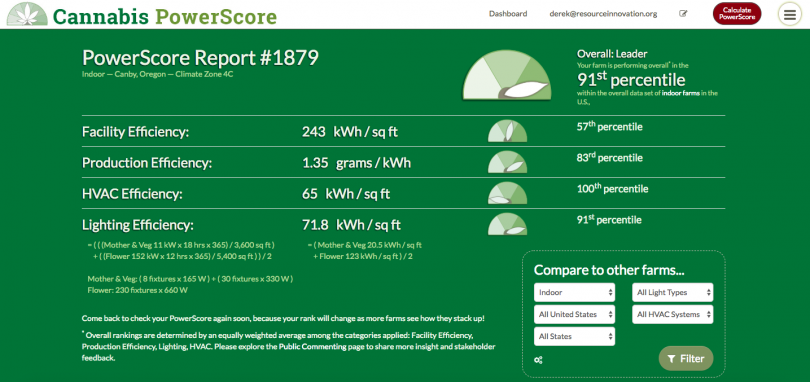The cannabis industry has made some huge strides.Even though the first steps of most movements are often the hardest, the closer we get to the coveted day when obtaining cannabis is no different than obtaining alcohol, new issues and challenges will need to be mitigated by policymakers and members of the cannabis industry.
Perhaps the most important issue of all is energy efficiency as its relevance spans all parties – cultivators, manufacturers, governments, states, consumers, and last but not least, the depleting natural resources mankind depends on.
Resource Innovation Institute (RII) is a non-profit organization that has taken up the hefty task of acting as a middleman between utilities, governments, manufacturers and stakeholders, helping all parties work together toward the common goal – “to inform best practices, policies, and programs that will drive energy efficiency,” as RII’s executive director Derek Smith puts it.
Organizations like the RII “are relatively common in more mature industries,” he explains, and even though “it’s taken a bit of time to get traction in this [the cannabis] industry” because of the many “distractions” it faces, Smith believes “the industry is maturing rapidly as it recognizes that resource efficiency is a critical piece of information of our collective future.”
A testament to this progress is the city of Goleta, located in Santa Barbara County, which included a requirement for energy assessment in its Cannabis Land Use Ordinance in the form of participation in RII’s Cannabis Power Score and engagement with utility efficiency programs.
The organization’s Cannabis PowerScore is a game-changing, in-depth survey that helps growers grasp “the interactive effects of energy, temperature and humidity in each stage of cultivation – and how to maximize energy efficiency while optimizing plant yields, consistency and quality.”
What makes the Cannabis PowerScore truly special is that it’s like “the dash” in the middle of a win-win situation – the more cultivators take it, the more the survey evolves.
Participants “not only receive an instant benchmark of their relative energy performance but they also contribute to an overall effort to create a more efficient future for cannabis,” Smith explains.
In other words, every cultivator and the data he/she inputs in the survey is like a pixel of a picture –more participants make a bigger, more detailed and “pixelated” picture. The aggregated data is used to “inform governments, utilities and manufacturers so they can create incentives and improve technology to drive conservation.”
Besides the instant benchmark, participants also receive different incentives like purchasing discounts from construction service providers. Because of this symbiotic element at its core, the Cannabis PowerScore can trigger a powerful momentum that could change the face and direction of the industry in the long run.
“Our goal is to provide an immediate ROI so that operators can maximize profitability and reinvest in efficient technologies that continue to drive down costs and environmental impacts,” Smith explains.
The Cannabis PowerScore reflects the collaboration between its different creators and their expertise in two separate niches which they have masterfully intersected – energy efficiency and the cannabis industry.
“I’ve worked at the intersection of sustainability and business for 20 years, and I’ve learned that it’s critically important to have the right set of experts working together to create solutions that drive both conservation and commerce,” Smith says.“Efforts without that combination always fail. We are so thrilled to work with the best minds in cannabis cultivation to guide our work!”
But the Cannabis PowerScore is only one of many major steps toward a more energy-efficient future which RII is determined to make. The masterminds at the non-profit are working toward aggregating funding for a North American baseline study of cannabis energy consumption that would set baselines for major groupings like indoor, outdoor, and greenhouse/mixed light cannabis production. Reliable baselines are essential for tracking the performance of energy-saving techniques and technologies, Smith explains.
RII is also in the process of developing a Cannabis Carbon Score and Cannabis Water Score which would work in a similar vein to the Cannabis PowerScore.
Furthermore, RII is supporting an indoor horticulture lighting efficacy standard, devised by the DesignLights Consortium, a non-profit organization, dedicated to accelerating the widespread adoption of high-performing commercial lighting solutions. The Design Light Consortium strives to be for lighting what RII has set out to be for the cannabis industry altogether – something like an unbiased judge.
“Purchasers of horticultural lighting will benefit from an independent evaluation of manufacturer claims so we can move away from the current “buyer beware” dynamic of LED lighting in cannabis, where some manufacturers are on the up and up, and many others appear not to be,” Smith says.
This is RII’s operational model in a nutshell, it’s exactly what makes the organization so proactive and pinpoint, even visionary– just like a film director who uses the tight expertise of video editors, sound technicians, etc. to make a cinematic vision come to life, RII does the same by collaborating with experts in the pertaining niches. And the film RII is envisioning is something everyone would want to tune into – it’s about an energy-efficient cannabis industry, for the sake of not only everyone involved in it, but for the environment altogether.
“Ultimately, our work will result in consumer knowledge about how to buy from industry leaders – in cultivation and extraction – whose environmental performance is verified,” Smith concludes.








